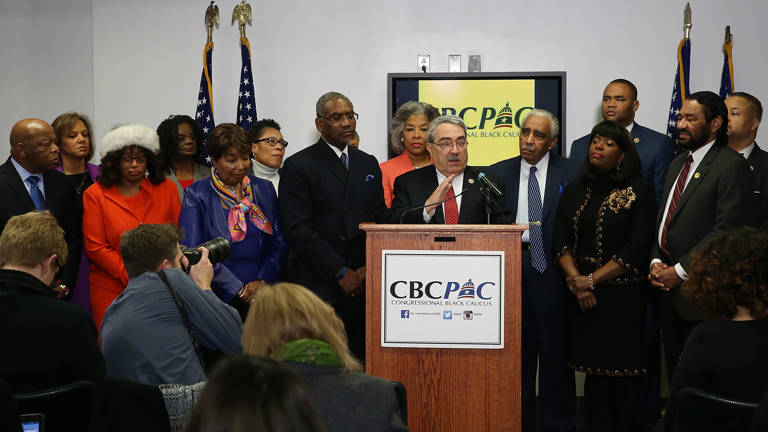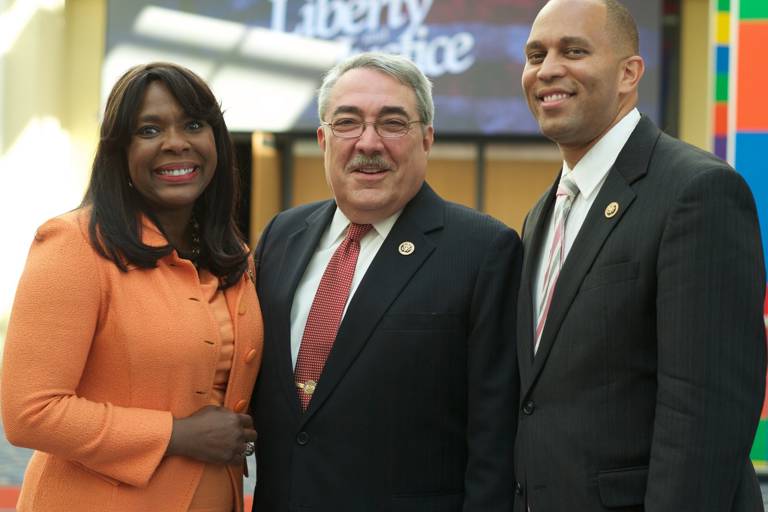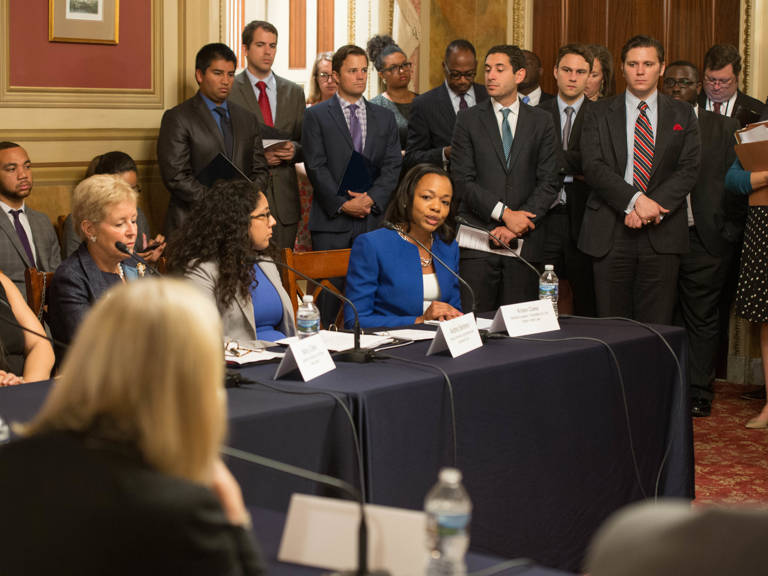G.K. Butterfield: From Grassroots Protests, to the Courtroom, to Congress

U.S. Rep. G.K. Butterfield (right) speaks while flanked by members of the Congressional Black Caucus during a news conference on Capitol Hill on April 22, 2015. (Photo by Mark Wilson/Getty Images)
For much of future U.S. Representative G.K. Butterfield Jr.’s youth, the only Black man who held elected office in Wilson County, North Carolina, an area about 45 miles east of Raleigh, was his father. G.K. Butterfield Sr. was a dentist, a founder of the local chapter of the National Association for the Advancement of Colored People (NAACP), and the first Black alderman of the city of Wilson, the county seat. Butterfield was 6 years old when his father won election in 1953, and he was 10 when a discriminatory change in voting laws thwarted his father’s reelection bid. For the next nearly three decades, Wilson County’s voting system diluted Black votes and kept Black candidates from office.
In a 2023 interview for the Legal Defense Fund Oral History Project, Butterfield said witnessing this injustice as a child ignited his interest in law and politics. As a lawyer, he joined forces with the Legal Defense Fund (LDF) in 1982 on a class action lawsuit that would become Thornburg v. Gingles, a seminal U.S. Supreme Court case that affirmed the District Court’s finding that multimember districts in North Carolina’s state legislative maps were discriminatory. In 2001, he became an Associate Justice on the North Carolina Supreme Court, and in 2004, he began 18 years of service representing North Carolina’s First Congressional District in the U.S. House of Representatives.
Through his collaboration with LDF, Butterfield played an important part in reversing the racially discriminatory at-large voting system that had ruined his father’s reelection bid nearly three decades before. The sequence of events that led to the change in Wilson County’s election law may never have begun had Butterfield, as a young lawyer, not taken the time to question the status quo.
Witnessing His Father’s Electoral Victories and Defeat
Butterfield’s father was an immigrant from Bermuda who attended Shaw University and Meharry Medical College before marrying Addie Lourine Davis and moving to Wilson, North Carolina, his wife’s hometown, in 1940. That year, North Carolina’s population was 27.5% Black, and the population of Wilson County, an agricultural community known for its tobacco market, was 42% Black. At first, the white community welcomed the elder Butterfield, the Black Baptist pastor’s new son-in-law. They even encouraged him to vote—leading him to become the 40th registered Black voter in Wilson County.
A practicing dentist and a member of the post-World War Two Black middle class, the elder Butterfield founded Wilson’s local NAACP chapter in 1947, the year of his son’s birth. By then, he had begun what his son later called a “one-man crusade” to register other Black voters. On Saturday afternoons, he and his wife, an elementary school teacher, led workshops to teach Black adults how to pass North Carolina’s literacy requirement for non-white voters.
In 1951, at the encouragement of a new young Baptist pastor named Talmadge Watkins, the elder Butterfield ran for alderman. The campaign’s success was largely due to Watkins, who brought with him a voter registration strategy that he had learned in Fayetteville, North Carolina. Wilson County had a ward voting system: Electors in each of six wards nominated an alderman to represent their interests. The population of Ward Three, where the elder Butterfield would run, was about equally divided between Black and white people, but 95% of its registered voters were white. By focusing Black voter registration efforts there, said Watkins, activists could mobilize the votes needed for a Black candidate. On May 5, 1953, after an exceedingly close vote, Butterfield won, becoming the fourth Black man elected to a city council in the entire state of North Carolina.
Over the next four years, the elder Butterfield became a beloved Black politician. He knew how to leverage the Black vote to make political deals with the mayor, fight for integration, and demand that taxpayer dollars support initiatives for Black youth as well as white. His methods earned praise from some white officials—the mayor made him the chair of the Finance Committee—and scorn from others.
“They knew that with political power, the Black community could radically transform local government and the quality of life,” his son reflected.

G.K. Butterfield speaks as part of the Congressional Black Caucus. (Photo by Mark Wilson/Getty Images)
He won reelection in 1955, but in 1957, the City Council replaced the ward voting system with an at-large system. This method diluted the Black vote in Ward Three, which was now overwhelmed by the white vote citywide. He lost his reelection bid.
“I knew it was wrong,” his son, who was 10 at the time of his father’s defeat, later recalled. “I knew my father was upset about it.”
As a child, Butterfield did not yet understand the election change as discriminatory, but he would in 1961, when Watkins ran for office. The elder Butterfield supported Watkins as he, the local NAACP, and a Black attorney went to court for an injunction to stop the election because of another discriminatory voting method called an “anti-single shot provision.” When the system changed to at-large elections, voters now had to vote for a slate of six citywide candidates, not just one—“a single shot”—for their ward. This practice confused some voters who were used to the ward voting system. Those who voted for fewer than six candidates had their ballots invalidated. Watkins’ team argued that the law should not make electors vote for more people than they wanted to support. NAACP lawyers filed Watkins v. Wilson in the North Carolina state courts and appealed up to the North Carolina Supreme Court, where they lost. They then petitioned the U.S. Supreme Court for review, which was denied.
Watkins lost the election because too many Black voters voted only for him and not for a full slate of candidates, resulting in a host of discarded Black ballots.
Activism in the Segregated South
Now 14 years old, the younger Butterfield understood the racist tactics at play in the voting system and throughout his daily life.
“I grew up in a totally segregated society in Wilson,” he said. “And when I say totally segregated, I don’t mean in some ways. In all ways.”
In the city of Wilson, a railroad track divided the Black and white communities. The tracks, part of the Atlantic Coast Line Railroad that stretched across the eastern part of North Carolina, were built by enslaved people in 1840. The younger Butterfield spent his childhood going to segregated movie theaters, restaurants, churches, and recreation centers. He knew that his mother had suffered from medical racism, and so had his uncle Fred Davis. A Black activist, Davis died in a Black hospital because a white doctor had refused to operate on him after he sustained injuries from a car accident—Davis had been riding his bike through town when a white motorist hit him.
As he realized the forces behind Watkins’ defeat, the teenage Butterfield saw the impact of the racial inequalities that suppressed Black lives in his hometown. “I put it all together,” he recalled. “This was racism.”
Within two years, he was channeling the lessons he learned from his father’s more diplomatic political dealings into his own brand of advocacy. “My father was negotiating with the retail stores to allow African Americans to get jobs and to sit at the lunch counters,” he said. “I was out on the street with picket signs and 200 or 300 other kids from the NAACP Youth chapter. We were protesting and demanding the integration of movie theaters and the like.”
In 1963, at age 17, Butterfield attended the March on Washington with his father. The following year, as a student at the historically Black North Carolina Central University, he volunteered for voter registration drives and supported campus employees who were on strike for better wages. Collaborating with his childhood friend Toby Fitch, he organized a three-day walk from Durham, North Carolina, to the courthouse in Wilson County to raise awareness of two Black politicians running for office. The candidates whom Butterfield and Fitch supported in the march lost, but voter registration for the election doubled.
Just as the younger Butterfield was developing a reputation for his activism, the local draft board flagged his name for the Selective Service draft even though he was still a college student.
“They want that boy off the street,” a Black member of the draft board reportedly told the Butterfields.
Using the Law to Strengthen Voting Rights
In 1974, after finishing his military service, college, and law school, Butterfield moved back to his hometown to start a law firm with Fitch. Several years later, over lunch, he asked his colleagues why all seven of the Wilson County commissioners were white, despite nearly 40% of the county’s population being Black. He knew this was a result of the discriminatory at-large voting measures implemented back in 1957, but he did not understand how, 25 years later, white officials in Wilson County were still legally able to use these election rules to marginalize Black voters. Since his father had held office in the mid-1950s, only one other Black man had served in an elected position—a candidate sponsored by white interest groups. Butterfield wondered whether the Voting Rights Act of 1965 could improve Wilson County’s electoral process and help Black candidates.
“There has to be something in this new law called the Voting Rights Act that we can use to stir it up,” he remembered saying.
After lunch, Butterfield went back to his office, called the U.S. Department of Justice (DOJ), and asked to speak with someone in the Voting Section of the Civil Rights Division. He was soon explaining his concerns to a woman named Mary Ann Jackman.
Jackman asked if there had been any recent changes in Wilson County’s election methods. The Voting Rights Act had explicitly designated “covered” jurisdictions—territories that had experienced more prevalent racially discriminatory voting practices because of their higher percentage of minority voters. Wilson County was one such covered jurisdiction. Jackman reminded Butterfield that, according to Section Five of the Voting Rights Act, when a covered jurisdiction changed a voting law or practice, it first had to get approval from the DOJ. Butterfield said that five years before, the method of electing county commissioners had changed to staggered terms. The Supreme Court previously held that the use of staggered terms affected Black voters’ ability to elect a representative of their own choice because such an election device decreased their ability to utilize single-shot voting. Similarly, in Wilson County, this practice of electing half the commissioners every two years—staggered terms—lessened the chance for minorities to elect their chosen officials.
Jackman found that the shift to staggered-term elections was one of three unapproved changes that Wilson County had made to its election methods. She asked Butterfield to write a letter directed to her documenting his concerns.
Following these directions, Butterfield wrote that Wilson County’s election changes had occurred “through a referendum that we believe was never submitted for preclearance as required by the Voting Rights Act.” He said it had been “impossible” for Black voters to elect a county commissioner in the past, and it would “now be doubly difficult to do so in the future because of the staggered terms.” He asked the DOJ to intervene.
It was this 1982 letter, Butterfield later said, that “precipitated and triggered a voting rights avalanche in eastern North Carolina.”
The DOJ soon sent a letter to Wilson County election officials saying they were in noncompliance with the Voting Rights Act. Until the Civil Rights Division received and evaluated the changes made to their election procedures, Wilson County could not hold another election. County commissioners called an emergency meeting, and after learning about the DOJ’s letter alleging Voting Rights Act violations, they had a lawyer file the necessary paperwork to demonstrate that the proposed voting changes would not result in Black people or other minority voters being worse off. When the Wilson County file reached the desk of William Bradford Reynolds, the U.S. Assistant Attorney General for the Civil Rights Division in the Reagan administration, he approved the “new” election methods. There would be no change to Wilson County’s voting procedures.
A Powerful Partnership with LDF
Butterfield would not accept defeat. He contacted his friend Julius Chambers, a lawyer in Charlotte, North Carolina, who said this was a case for LDF. Soon, Butterfield was on a plane to New York City, where on March 15, 1982, he met with LDF voting rights attorneys Lani Guinier and Napoleon Williams. The lawyers told Butterfield that he had a strong case against the county commissioners. They believed that Wilson County’s discriminatory voting procedures, such as staggered-term elections, violated Section Five of the Voting Rights Act as well as Section Two, which prohibits a state or a political subdivision of a state from using any “standard, practice, or procedure” that “results in a denial or abridgement of the right of any citizen of the United States to vote on account of race or color.”
Butterfield told Guinier and Williams that the problem went deeper than the flawed election methods for county commissioners. For decades, he said, racist voting procedures had spread through city government, keeping Black politicians from every office, including City Council. He explained that the election of his father as the first Black alderman on the City Council in 1953 had precipitated voting changes that diluted the Black vote. He wanted LDF to sue the City Council, along with the county commissioners, for violating Section Two of the Voting Rights Act. However, the LDF lawyers said they needed to focus on what they were sure they could win: a case against the county commissioners.
They enlisted Butterfield’s help in identifying potential plaintiffs and then filed a lawsuit. But before the case reached the courts, Chambers called to say there was a concern about whether the legal team could prove that the election methods resulted from intentional discrimination, a criterion of the Voting Rights Act.
“While I think you have a case that stinks in Wilson County, I’m not sure we can prove intentional discrimination,” Butterfield recalled Chambers saying.
Section Five of the Voting Rights Act required Congress to periodically reauthorize the law, and in the spring of 1982, a bipartisan group of senators—including Ted Kennedy, Joe Biden, Bob Dole, and Orrin Hatch—were fighting a contentious battle on its behalf. Chambers said that if these senators were successful, they could change the proof required in discrimination cases from an intent to discriminate to the effects stemming from discrimination. The latter would be much easier to prove in court.
Butterfield headed to the Senate chamber in Washington, D.C. From his seat in the gallery, he watched the Voting Rights Act extension debates. The amendments did pass, and on June 29, 1982, President Ronald Reagan signed a 25-year extension of the Voting Rights Act.
The first Supreme Court case to test the strength of these amendments was Thornburg v. Gingles. Butterfield, who worked with LDF on the case, went to the North Carolina legislature for hearings on redistricting and made the case for breaking up multimember voting districts in favor of single-member districts. With his help, LDF won Thornburg v. Gingles. The ruling declared North Carolina’s multimember voting districts invalid because they “impaired Black citizens’ ability to elect representatives of their choice,” and it required the North Carolina General Assembly to break them up into single-member districts.
“Because of that, we went from two or three Black [state] legislators to 20 or more in the legislature,” Butterfield said.
His personal fight against racist voting systems was not over, however. He had become a lawyer to challenge the lack of Black elected officials, and in his home county, the City Council still used the at-large voting system that had kept his father from reelection. Wanting to right the electoral wrongs he had witnessed as a boy, Butterfield decided to sue the City Council for violating the Voting Rights Act—with or without LDF’s help.

G.K. Butterfield (center) at the Congressional Black Caucus’ 45th Annual Legislative Conference. (Photo by Earl Gibson III/Getty Images)
In the end, he did not have to file a lawsuit. When the Council learned of Butterfield’s intention, it voluntarily changed the at-large system back to the single-ward (now district) system. The Board of Education soon also changed its process of electing board members from an at-large voting system to a district voting system.
“And because of that,” Butterfield said, “we now have so many African Americans serving on these boards, it’s just heartwarming.”
Since LDF’s victory in Thornburg v. Gingles, Butterfield has fielded requests from districts across the South for help in fighting racist voting practices. He has referred multiple cases to LDF and gives the organization credit for its work on voting rights.
“The NAACP Legal Defense Fund has been the catalyst in transforming the political systems of the South, and we are grateful for it, and we are better off because of it,” Butterfield said.
This voting rights work is crucial, according to Butterfield: “Without changing political systems, then you don’t change economic opportunities and you don’t change other things that are important to minority groups.”



